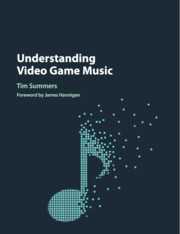Book contents
- Frontmatter
- Dedication
- Contents
- List of Figures, Musical Examples and Tables
- Foreword
- Acknowledgements
- Introduction: Beyond the Candelabrum
- PART I ANALYSING VIDEO GAME MUSIC
- 1 The Video Game as a Source
- 2 Methods of Analysis
- PART II CRITICAL PERSPECTIVES
- Epilogue: Fun, Play and Music
- Appendix: How to Hear a Video Game: An Outline
- Bibliography
- Ludography
- Index of Games
- General Index
2 - Methods of Analysis
from PART I - ANALYSING VIDEO GAME MUSIC
Published online by Cambridge University Press: 05 September 2016
- Frontmatter
- Dedication
- Contents
- List of Figures, Musical Examples and Tables
- Foreword
- Acknowledgements
- Introduction: Beyond the Candelabrum
- PART I ANALYSING VIDEO GAME MUSIC
- 1 The Video Game as a Source
- 2 Methods of Analysis
- PART II CRITICAL PERSPECTIVES
- Epilogue: Fun, Play and Music
- Appendix: How to Hear a Video Game: An Outline
- Bibliography
- Ludography
- Index of Games
- General Index
Summary
The previous chapter explored some of the knotty conceptual issues surrounding video game music, specifically with respect to the complex textuality of the game source. While the multidimensionality of the game text is challenging, it also allows for a plethora of different approaches to game music. Part of the rewarding joy of investigating game music comes from the variety of different modes and methods for studying music in games. Like the player-empowered texts themselves, games allow us to experiment, test and explore different analytical approaches. The second part of this book deals with conceptual perspectives on video game music, but first, this chapter will discuss some of the materials and methods for analysing game music.
I certainly do not wish to prescribe a single approach to investigating game music – such an attitude would be entirely antithetical to the aim of this volume to open up video games for musical exploration. Instead, I hope to point the way towards some of the sources and modes of analysis that I have found to be most useful and rewarding, and in particular, those that will be utilized in coming chapters to underpin the conceptual perspectives outlined in Part II of this book.
The motivations for analysing game music are similarly many and varied. Whether we want to trace a technological history of music for games, work out how music contributes to the gameplay experience, consider the musical educations that games provide, or conduct any number of other investigations into game music, careful examination of the games, and their music, is necessary. Many of the ‘uses’ of the kinds of analyses outlined here are demonstrated later in the volume, since the conclusions and perspectives that I draw are founded, at least in part, upon the close analysis of the game music such as I advocate here. The conclusions of analysis are not limited to retrospective explanations, they may also usefully inform future musical creation by providing models and case studies of different musical practices with a variety of outcomes. Any analysis will be tailored to the investigative questions at hand, whether they are as specific as seeking to understand the form of a musical cue, examining musical precedents for a particular type of game, or as general as using music to help answer the question of why people enjoy video games.
Information
- Type
- Chapter
- Information
- Understanding Video Game Music , pp. 33 - 54Publisher: Cambridge University PressPrint publication year: 2016
